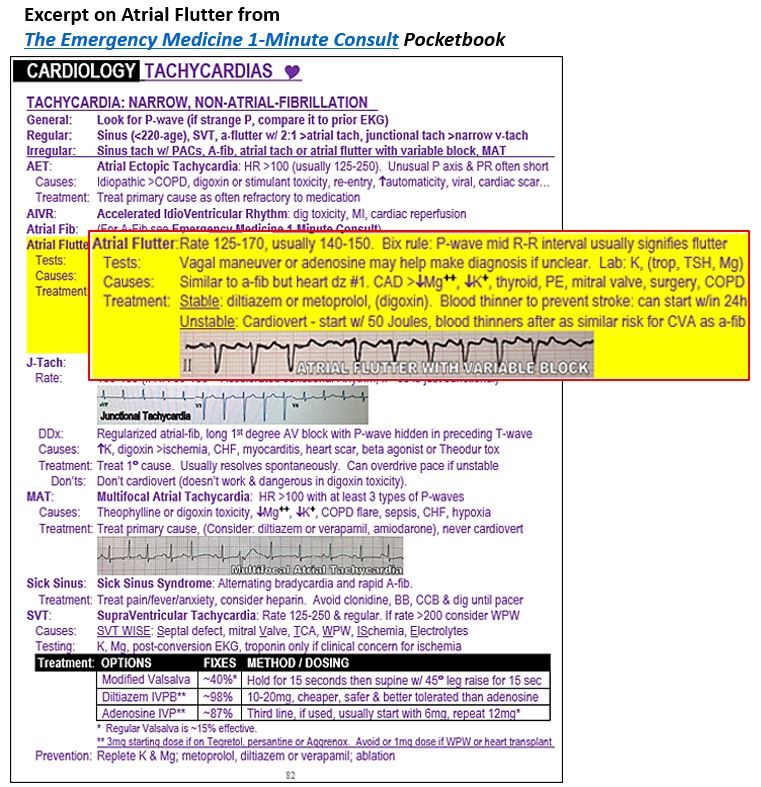- Clinical Technology
- Adult Immunization
- Hepatology
- Pediatric Immunization
- Screening
- Psychiatry
- Allergy
- Women's Health
- Cardiology
- Pediatrics
- Dermatology
- Endocrinology
- Pain Management
- Gastroenterology
- Infectious Disease
- Obesity Medicine
- Rheumatology
- Nephrology
- Neurology
- Pulmonology
Arrhythmia after an Energy Drink: SVT?
ECG Challenge: A 32-year-old woman is brought by ambulance to the ED. She is having palpitations after consuming 2 energy drinks. What's your ECG read?
Figure 1. (Please click to enlarge)

Figure 2. (Please click to enlarge)

History. A 32-year-old woman with a history of congenital heart disease is brought by ambulance to the emergency department (ED) complaining of palpitations after drinking 2 energy drinks. Medics say she is in supraventricular tachycardia (SVT) but has not responded to adenosine 6 mg and 12 mg. On arrival she denies chest pain, shortness of breath, or other complaints. She also denies any recreational drug use.
Physical examination. Vital signs are normal except for a pulse of 153 beats/min. Results of her physical examination are normal except for tachycardia. A 12-lead ECG performed in triage is read as SVT with a rate of 148 beats/min.
Initial differential diagnosis
- SVT
- Sinus tachycardia
- Atrial flutter
- Junctional tachycardia
Initial diagnostic testing
- Results of CBC, hCG, and basic metabolic panel, all normal
- A rhythm strip before and after 12 mg of adenosine is shown in Figure 1above (please click to enlarge). The arrow indicates where the adenosine was given.
Questions
- What does the case image (Figure 1) show?
- What should you do next?
Please click here for answers and discussion.
Answers
- What does the case image show? The image shows atrial flutter that is slowed by the adenosine, thereby making it easier to see
- What should you do next? Give a calcium channel blocker and consult cardiology and the hospitalist. Search for a cause of atrial flutter.
For at-a-glance details, see yellow highlighted area from sample page in Figure 2, above.
Discussion
Atrial flutter can be regular or irregular depending on which of the flutter waves are conducted through to the ventricles. Flutter waves are typically close to 300 beats/min. Most commonly every other atrial depolarization is conducted (2-to-1 block) leading to a ventricular rate close to 150 beats/min. This can look similar to SVT and the ECG computer may interpret the atrial rhythm incorrectly. If the block is variable or higher level, like 3-to-1, then atrial flutter becomes much more obvious. Vagal maneuvers or AV nodal blockers like adenosine or diltiazem can accomplish this and confirm the diagnosis.
Testing should usually include a potassium level as hypokalemia can cause or contribute to atrial flutter. Other tests that are often ordered but not mandatory include troponin, magnesium, and TSH because ischemia, hypomagnesemia, and hyperthyroidism are other causes.
Treatment of atrial flutter, like all dysrhythmias, depends on stability. Flutter is rarely a cause of instability, but if there is concern that it is then immediate cardioversion is indicated; 50 joules is usually sufficient. In the stable patient diltiazem or beta blockers are both first-line agents for rate control. Digoxin is rarely used. Anticoagulants should be considered for stroke prevention, but rarely need to be started in the first 24 hours after symptom onset.
Conclusion
Adenosine is short-lived so the patient’s heart rate spiked again. Diltiazem was used and effectively slowed the rate. The patient spontaneously converted to NSR in the ED. Her cardiologist was contacted and a team decision was made to send her home.
